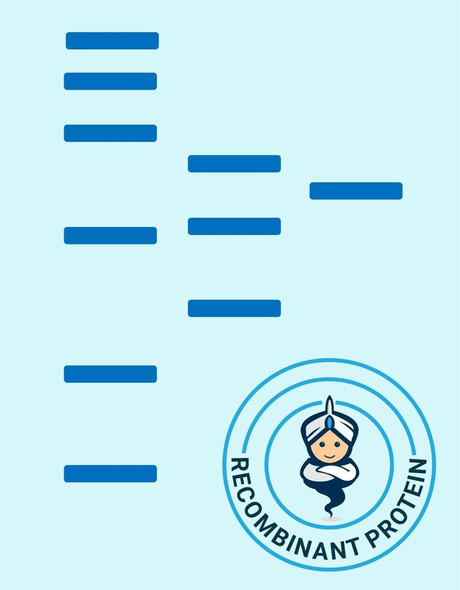Human S100A1 Recombinant Protein (RPPB4544)
- SKU:
- RPPB4544
- Product type:
- Recombinant Protein
- Size:
- 10ug
- Species:
- Human
- Target:
- S100A1
- Synonyms:
- Protein S100-A1
- S100 calcium-binding protein A1
- S-100 protein alpha subunit
- S-100 protein alpha chain
- Source:
- Escherichia Coli
- Uniprot:
- P23297
Description
| Product Name: | Human S100A1 Recombinant Protein |
| Product Code: | RPPB4544 |
| Size: | 10µg |
| Species: | Human |
| Target: | S100A1 |
| Synonyms: | Protein S100-A1, S100 calcium-binding protein A1, S-100 protein alpha subunit, S-100 protein alpha chain, S100A1, S100A, S100, S100-alpha, S100-A1. |
| Source: | Escherichia Coli |
| Physical Appearance: | White lyophilized (freeze-dried) powder. |
| Formulation: | The S100A1 protein was lyophilized from 0.4µm filtered solution at a concentration of 0.5mg/ml containing 20mM Tris pH-7.5 and 50mM NaCl. |
| Solubility: | Add deionized water to a working concentration approximately 0.5mg/ml and let the lyophilized pellet dissolve completely. Product is not sterile! Please filter the product by appropriate sterile filter before using it in the cell culture. |
| Stability: | Lyophilized S100A1 although stable at room temperature for 3 weeks, should be stored desiccated below -18°C. Upon reconstitution S100A1 should be stored at 4°C between 2-7 days and for future use below -18°C.For long term storage it is recommended to add a carrier protein (0.1% HSA or BSA).Please prevent freeze-thaw cycles. |
| Purity: | Greater than 95.0% as determined by SDS-PAGE. |
| Amino Acid Sequence: | MKHHHHHHAS GSELETAMET LINVFHAHSG KEGDKYKLSK KELKELLQTE LSGFLDAQKD VDAVDKVMKE LDENGDGEVD FQEYVVLVAA LTVACNNFFW ENS |
S100A1 is a member of the S100 family of calcium binding proteins with EF-hand type Ca+2 binding motive. S100A1 (Calcium Binding Protein A1) is involved in the activation of sarcoplasmatic calcium release and the regulation of intermediate filament polymerization. S100A1 may function in stimulation of Ca2+-induced Ca2+ release, inhibition of microtubule assembly, and inhibition of protein kinase C-mediated phosphorylation. Reduced expression of S100A1 has been implicated in cardiomyopathies.S100 proteins are localized either in the cytoplasm or the nucleus of a wide range of cells. There are at least 13 members in the S100 gene family, which are located as a cluster on chromosome 1q21.
S100A1 Human Recombinant produced in E.Coli is a single, non-glycosylated, polypeptide chain containing 103 amino acids which include a 10 amino acid His Tag fused at N-terminus and having a total molecular mass of 11.66 kDa. S100A1 Human Recombinant is purified by proprietary chromatographic techniques.
| UniProt Protein Function: | Function: Weakly binds calcium but binds zinc very tightly-distinct binding sites with different affinities exist for both ions on each monomer. Physiological concentrations of potassium ion antagonize the binding of both divalent cations, especially affecting high-affinity calcium-binding sites. May mediate calcium-dependent regulation on many physiological processes by interacting with other proteins, such as TPR-containing proteins, and modulating their activity. Ref.13 |
| UniProt Protein Details: | Subunit structure: Dimer of either two alpha chains, or two beta chains, or one alpha and one beta chain. Also forms heterodimers with S100P. Interacts with AGER and CAPZA1. Interacts with FKBP4. Interacts with RYR1 and RYR2. Interacts with CACYBP in a calcium-dependent manner. Interacts with PPP5C (via TPR repeats); the interaction is calcium-dependent and modulates PPP5C activity. Ref.8 Ref.9 Ref.10 Ref.11 Ref.13 Ref.14 Subcellular location: Cytoplasm. Tissue specificity: Highly prevalent in heart. Also found in lesser quantities in skeletal muscle and brain. Sequence similarities: Belongs to the S-100 family.Contains 2 EF-hand domains. |
| NCBI Summary: | The protein encoded by this gene is a member of the S100 family of proteins containing 2 EF-hand calcium-binding motifs. S100 proteins are localized in the cytoplasm and/or nucleus of a wide range of cells, and involved in the regulation of a number of cellular processes such as cell cycle progression and differentiation. S100 genes include at least 13 members which are located as a cluster on chromosome 1q21. This protein may function in stimulation of Ca2+-induced Ca2+ release, inhibition of microtubule assembly, and inhibition of protein kinase C-mediated phosphorylation. Reduced expression of this protein has been implicated in cardiomyopathies. [provided by RefSeq, Jul 2008] |
| UniProt Code: | P23297 |
| NCBI GenInfo Identifier: | 134136 |
| NCBI Gene ID: | 6271 |
| NCBI Accession: | P23297.2 |
| UniProt Secondary Accession: | P23297,Q5T7Y3, B2R5D9, |
| UniProt Related Accession: | P23297 |
| Molecular Weight: | |
| NCBI Full Name: | Protein S100-A1 |
| NCBI Synonym Full Names: | S100 calcium binding protein A1 |
| NCBI Official Symbol: | S100A1 |
| NCBI Official Synonym Symbols: | S100; S100A; S100-alpha |
| NCBI Protein Information: | protein S100-A1; S100 alpha; S-100 protein alpha chain; S-100 protein subunit alpha; S100 calcium-binding protein A1; S100 protein, alpha polypeptide |
| UniProt Protein Name: | Protein S100-A1 |
| UniProt Synonym Protein Names: | S-100 protein alpha chain; S-100 protein subunit alpha; S100 calcium-binding protein A1 |
| UniProt Gene Name: | S100A1 |
| UniProt Entry Name: | S10A1_HUMAN |










